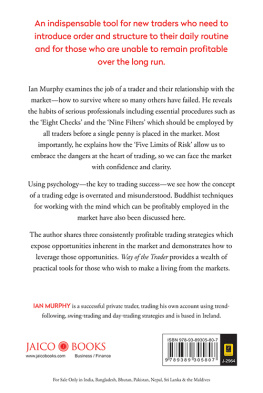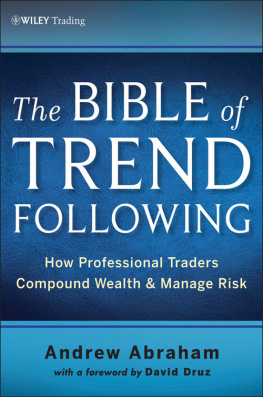Publishing Details
HARRIMAN HOUSE LTD
3A Penns Road
Petersfield
Hampshire
GU32 2EW
GREAT BRITAIN
Tel: +44 (0)1730 233870
Fax: +44 (0)1730 233880
Email: enquiries@harriman-house.com
Website: www.harriman-house.com
First published in Great Britain in 2010
This eBook 2011
Copyright Harriman House Ltd
The right of James Clunie to be identified as the author has been asserted
in accordance with the Copyright, Design and Patents Act 1988.
ISBN: 978-0-85719-151-9
British Library Cataloguing in Publication Data
A CIP catalogue record for this book can be obtained from the British Library.
All rights reserved; no part of this publication may be reproduced, stored in a retrieval system, or transmitted in any form or by any means, electronic, mechanical, photocopying, recording, or otherwise without the prior written permission of the Publisher. This book may not be lent, resold, hired out or otherwise disposed of by way of trade in any form of binding or cover other than that in which it is published without the prior written consent of the Publisher.
No responsibility for loss occasioned to any person or corporate body acting or refraining to act as a result of reading material in this book can be accepted by the Publisher, by the Author, or by the employer of the Author.
About the Author
James Clunie works at Scottish Widows Investment Partnership (SWIP), where he is responsible for managing a UK equity long-short fund and a long-only fund. Previously, he was at the University of Edinburgh for four years, conducting research into stock lending and short-selling. He also set up and ran their Masters programme in Finance and Investment. Prior to this, Clunie worked at Murray Johnstone International, where he was head of asset allocation, and at Aberdeen Asset Management, where he was head of global equities. He graduated with a BSc (Hons) in Mathematics and Statistics and recently completed his PhD on indirect short-selling constraints, both at the University of Edinburgh. He is a chartered financial analyst.
Acknowledgements
I would like to thank Stephen Eckett for suggesting that I write this book and for his effective editing work. I would also like to thank Suzanne Anderson for guiding me through the publishing process. It has been a pleasure to work with each member of the team at Harriman House on this project.
Special thanks go to Nelly Terekhova for her research assistance on this book.
Thanks to Yuan Gao and Tatiana Pyatigorskaya for their assistance in building and analysing the dataset used to examine short-sellers behaviour. Also, thanks to Charalambos Constantinou for his work in analysing index fund predation and to Mariam Megvinetuhutsesi for her assistance in researching the ethics of predatory trading.
I am grateful to Will Duff Gordon at Data Explorers Ltd and Catherine Somers at Datastream Ltd. for providing valuable data for this research. I am also grateful to the quantitative research team at Macquarie and to Neil Heywood at Matrix Trading Systems, each of whom gave me permission to use their research findings on the use of stop losses.
I would like to thank all those who agreed to be interviewed for aspects of my research. Finally, thanks to reviewers and participants at the Midwest Finance Association conference in Chicago (March, 2009), the European Financial Management conference in Nantes (April, 2009), the State Street Risk Forum (2007), the Edinburgh University Centre for Financial Markets Research (2008), the JP Morgan Quantitative Conference (2008) and the CFA/INQUIRE seminar in London (February, 2009) for their helpful ideas and suggestions on research that was used in this book.
Preface
What this book is about
In this book I look at a series of phenomena that can drive security prices temporarily away from their equilibrium levels, creating opportunities for traders to profit from. At the same time, these phenomena create the risk of losses for the unaware.
The phenomena I examine have only recently begun to be better understood. They include two important liquidity problems faced by traders: predatory trading and crowded exits. I examine these on three levels. Firstly, I describe the basic principles and theory behind the phenomena, to build a solid framework for the way we think about these situations. Secondly, I examine the accumulated empirical evidence on these events. This reveals what has generally happened in these situations, and what the profit opportunity and risks might be like. Finally, I consider a number of individual cases to illustrate what can happen to traders in practice. In the main, these will be extreme events or special situations from which we can learn.
By understanding these phenomena in this way a trader could gain an edge over others in the market. In the first instance, this is achieved by avoiding becoming the victim of the phenomena I describe. Beyond this, it might be possible to use detailed knowledge of some of these situations to (legally and ethically) profit from the events.
Who this book is for
This book should be of interest to traders seeking to gain a superior understanding of how markets work, both in theory and in practice. It should also be of interest to longer-horizon investors who are seeking to avoid timing errors, and to risk managers seeking to understand better the subtleties of risk beyond traditional risk statistics. Finally, I expect that a number of academics and students of markets will find this work stimulating and thought-provoking.
How the book is structured
The book starts with an introduction to the notion of the fair value of a security. Then, by thinking of markets as an eco-system of different types of players, I describe ways in which securities prices can move away from equilibrium and stay mis-priced for some time. I examine specific examples of these phenomena, include predatory trading, the use of stop losses, crowded exits and manipulation. I end with some thoughts on how traders should make use of their knowledge of these phenomena.
Introduction
Imagine the following situation. You are a trader who understands the relationship between two similar assets. That relationship appears out of line with its historical pattern and little has changed in the way of fundamentals over the past few months. You place the trade, hedging one asset against the other. Now, you only need to wait for convergence
But it doesnt happen.
The trade moves the other way and you are now nursing a painful loss. No matter, you think, the fundamentals remain unchanged and the trade now looks more attractive than ever. You even try to encourage convergence by advertising the attractiveness of this position to other traders.
But then your position falls to an even greater loss. You are reminded of your head traders favourite piece of advice:
The market will move to the point that causes the maximum pain
Its beginning to feel that way. If the trade diverges any further you will be stopped out by your own risk controls.
The trade continues to diverge, the pain builds and you are indeed stopped out.
A few days later you see that the two assets have moved sharply back towards their historical relationship. You were correct in your original analysis. But somehow the market had conspired to impose swingeing losses on you.
How did this happen?
Every trader should have a thorough understanding of phenomena such as predatory trading and manipulation; and of liquidity problems that can arise when traders position themselves in a similar fashion to one another. These problems are often understood intuitively, but there is a benefit from understanding the theory behind them and from seeing the evidence of how they work.









